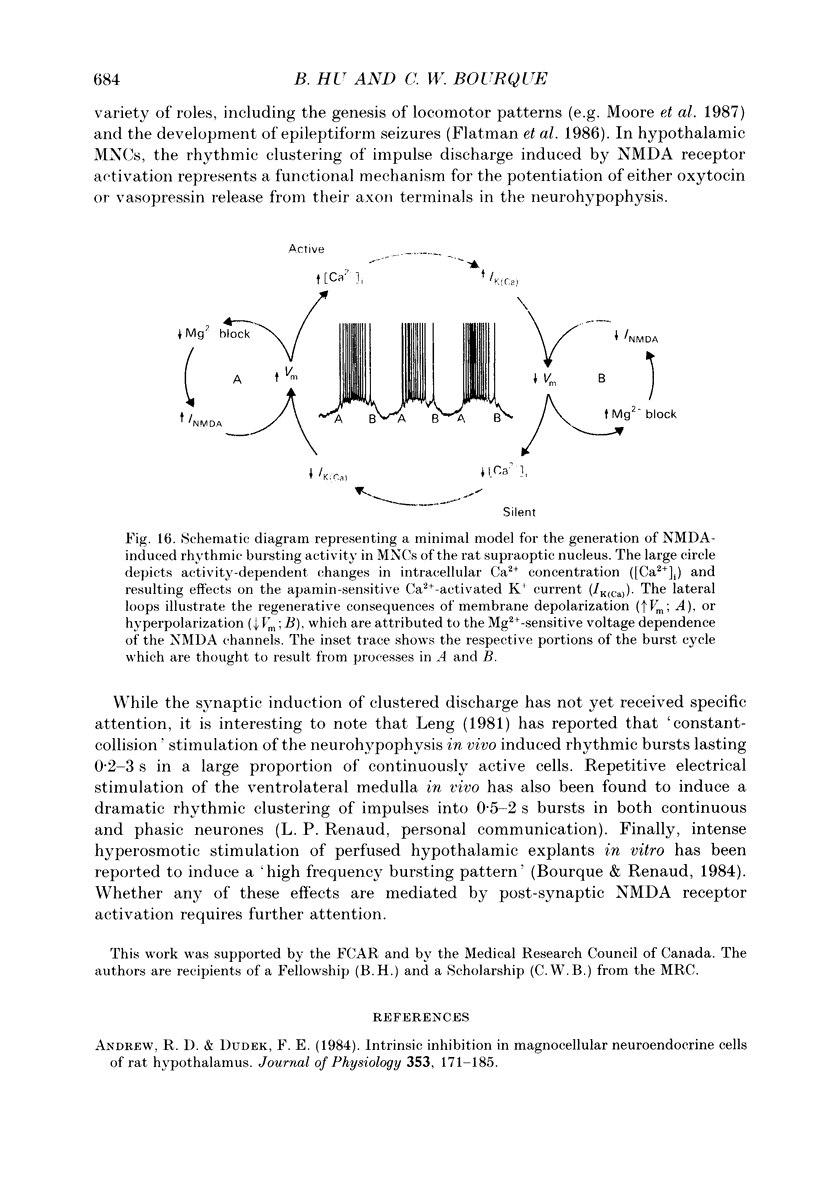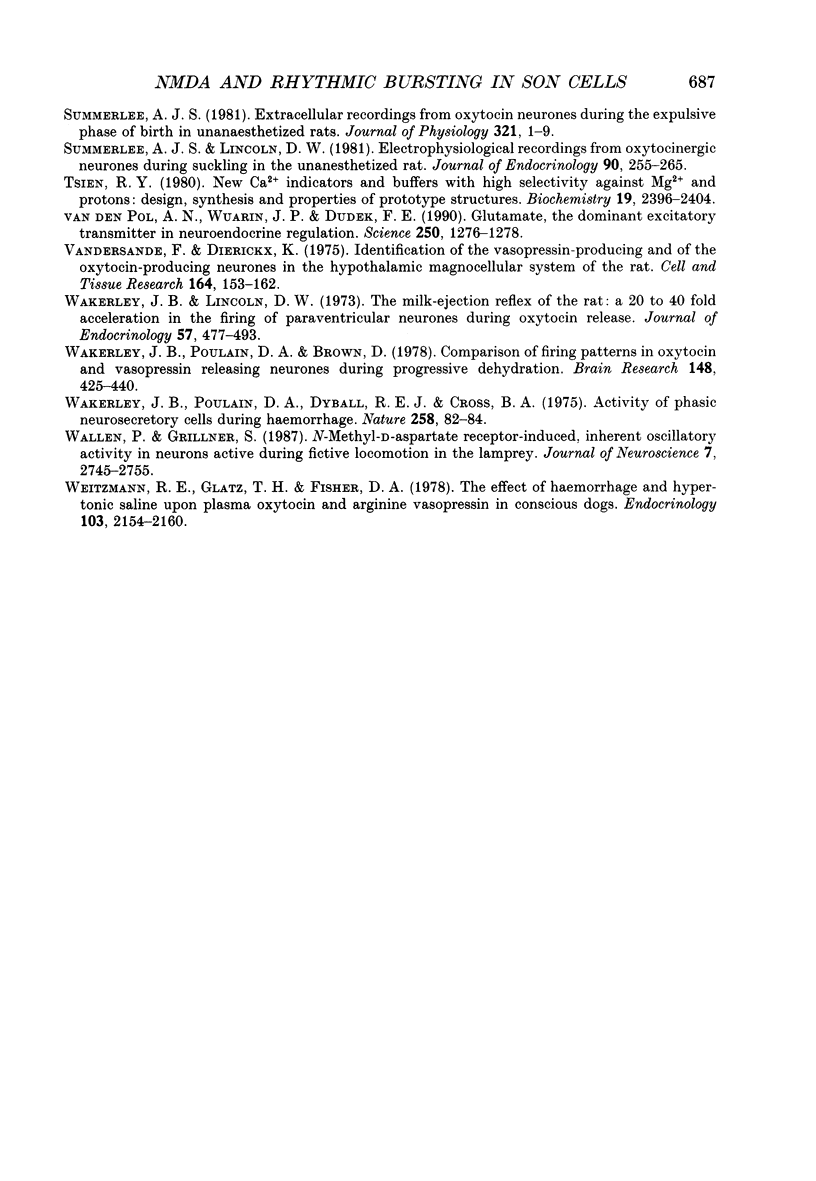Abstract
1. Intracellular recordings were obtained from 112 supraoptic nucleus magnocellular neurosecretory cells (MNCs) in superfused explants of rat hypothalamus maintained in vitro. The effects of glutamate receptor agonists and antagonists were examined at 32-34 degrees C. 2. In control solutions, spontaneously active (> 5 Hz) phasic or continuous neurones showed interspike interval distributions slightly skewed toward short intervals, but did not feature pauses in the 0.4-2 s range. Current injection to alter the rate of cell discharge shifted the histograms according to the mean firing rate, but failed to induce intermittent pauses in the 0.4-2 s range. 3. Application of N-methyl-D-aspartate (NMDA) induced a mode of firing in which bimodal interspike interval distributions reflected a high incidence of clusters of short interspike intervals (0.5-1.5 s) recurring every 1-3 s. In contrast, firing evoked by application of D,L-alpha-amino-3-hydroxy-5-methyl-4-isoxalone propionic acid (AMPA) was not associated with a clustering of impulse discharge. 4. The putative endogenous excitatory amino acid transmitters L-glutamate, L-aspartate and quinolinate all mimicked the effects of NMDA. Clustered spiking responses to these agents were reversibly blocked by D,L-2-amino-5-phosphono-valerate (APV), but not by 6-cyano-7-nitroquinoxaline-2,3-dione (CNQX). In contrast, the non-NMDA receptor ligands kainate and quisqualate caused CNQX-sensitive increases in firing rate, but these responses were not associated with the appearance of clustered activity. 5. When applied to cells showing negative resting potentials (< -70 mV), or to neurones hyperpolarized by current injection, responses to NMDA consisted of rhythmic (approximately 1 Hz) voltage oscillations associated with bursts of spike discharge. In the presence of TTX, NMDA could induce subthreshold voltage oscillations in the absence of action potentials. 6. Application of a voltage clamp to potentials between -75 and -55 mV during rhythmic bursting responses failed to reveal any rhythmic oscillation of the membrane current. In all cases, rhythmic bursting activity resumed upon returning to the current-clamp mode. 7. Rhythmic bursting responses to NMDA application were abolished in Mg(2+)-free solutions, suggesting that the voltage dependence of NMDA channels served to promote regenerative voltage changes throughout the cycle. The NMDA-induced current itself, however, did not appear to decrease with time, suggesting that a distinct, outward current, was necessary to initiate the repolarizing phase of each cycle.(ABSTRACT TRUNCATED AT 400 WORDS)
Full text
PDF




















Selected References
These references are in PubMed. This may not be the complete list of references from this article.
- Andrew R. D., Dudek F. E. Intrinsic inhibition in magnocellular neuroendocrine cells of rat hypothalamus. J Physiol. 1984 Aug;353:171–185. doi: 10.1113/jphysiol.1984.sp015330. [DOI] [PMC free article] [PubMed] [Google Scholar]
- Bicknell R. J., Leng G. Relative efficiency of neural firing patterns for vasopressin release in vitro. Neuroendocrinology. 1981 Nov;33(5):295–299. doi: 10.1159/000123248. [DOI] [PubMed] [Google Scholar]
- Bicknell R. J. Optimizing release from peptide hormone secretory nerve terminals. J Exp Biol. 1988 Sep;139:51–65. doi: 10.1242/jeb.139.1.51. [DOI] [PubMed] [Google Scholar]
- Bourque C. W., Brown D. A. Apamin and d-tubocurarine block the afterhyperpolarization of rat supraoptic neurosecretory neurons. Neurosci Lett. 1987 Nov 23;82(2):185–190. doi: 10.1016/0304-3940(87)90127-3. [DOI] [PubMed] [Google Scholar]
- Bourque C. W., Randle J. C., Renaud L. P. Calcium-dependent potassium conductance in rat supraoptic nucleus neurosecretory neurons. J Neurophysiol. 1985 Dec;54(6):1375–1382. doi: 10.1152/jn.1985.54.6.1375. [DOI] [PubMed] [Google Scholar]
- Bourque C. W., Renaud L. P. Activity patterns and osmosensitivity of rat supraoptic neurones in perfused hypothalamic explants. J Physiol. 1984 Apr;349:631–642. doi: 10.1113/jphysiol.1984.sp015178. [DOI] [PMC free article] [PubMed] [Google Scholar]
- Bourque C. W., Renaud L. P. Membrane properties of rat magnocellular neuroendocrine cells in vivo. Brain Res. 1991 Feb 1;540(1-2):349–352. doi: 10.1016/0006-8993(91)90535-4. [DOI] [PubMed] [Google Scholar]
- Bourque C. W. Transient calcium-dependent potassium current in magnocellular neurosecretory cells of the rat supraoptic nucleus. J Physiol. 1988 Mar;397:331–347. doi: 10.1113/jphysiol.1988.sp017004. [DOI] [PMC free article] [PubMed] [Google Scholar]
- Brimble M. J., Dyball R. E., Forsling M. L. Oxytocin release following osmotic activation of oxytocin neurones in the paraventricular and supraoptic nuclei. J Physiol. 1978 May;278:69–78. doi: 10.1113/jphysiol.1978.sp012293. [DOI] [PMC free article] [PubMed] [Google Scholar]
- Brown D. A., Griffith W. H. Calcium-activated outward current in voltage-clamped hippocampal neurones of the guinea-pig. J Physiol. 1983 Apr;337:287–301. doi: 10.1113/jphysiol.1983.sp014624. [DOI] [PMC free article] [PubMed] [Google Scholar]
- Cazalets J. R., Grillner P., Menard I., Cremieux J., Clarac F. Two types of motor rhythm induced by NMDA and amines in an in vitro spinal cord preparation of neonatal rat. Neurosci Lett. 1990 Mar 26;111(1-2):116–121. doi: 10.1016/0304-3940(90)90354-c. [DOI] [PubMed] [Google Scholar]
- Cazalis M., Dayanithi G., Nordmann J. J. The role of patterned burst and interburst interval on the excitation-coupling mechanism in the isolated rat neural lobe. J Physiol. 1985 Dec;369:45–60. doi: 10.1113/jphysiol.1985.sp015887. [DOI] [PMC free article] [PubMed] [Google Scholar]
- Day T. A., Renaud L. P., Sibbald J. R. Excitation of supraoptic vasopressin cells by stimulation of the A1 noradrenaline cell group: failure to demonstrate role for established adrenergic or amino acid receptors. Brain Res. 1990 May 14;516(1):91–98. doi: 10.1016/0006-8993(90)90901-m. [DOI] [PubMed] [Google Scholar]
- Dutton A., Dyball R. E. Phasic firing enhances vasopressin release from the rat neurohypophysis. J Physiol. 1979 May;290(2):433–440. doi: 10.1113/jphysiol.1979.sp012781. [DOI] [PMC free article] [PubMed] [Google Scholar]
- Flatman J. A., Schwindt P. C., Crill W. E., Stafstrom C. E. Multiple actions of N-methyl-D-aspartate on cat neocortical neurons in vitro. Brain Res. 1983 Apr 25;266(1):169–173. doi: 10.1016/0006-8993(83)91323-9. [DOI] [PubMed] [Google Scholar]
- Flatman J. A., Schwindt P. C., Crill W. E. The induction and modification of voltage-sensitive responses in cat neocortical neurons by N-methyl-D-aspartate. Brain Res. 1986 Jan 15;363(1):62–77. doi: 10.1016/0006-8993(86)90659-1. [DOI] [PubMed] [Google Scholar]
- Gribkoff V. K., Dudek F. E. Effects of excitatory amino acid antagonists on synaptic responses of supraoptic neurons in slices of rat hypothalamus. J Neurophysiol. 1990 Jan;63(1):60–71. doi: 10.1152/jn.1990.63.1.60. [DOI] [PubMed] [Google Scholar]
- Grillner S., Wallén P. The ionic mechanisms underlying N-methyl-D-aspartate receptor-induced, tetrodotoxin-resistant membrane potential oscillations in lamprey neurons active during locomotion. Neurosci Lett. 1985 Oct 10;60(3):289–294. doi: 10.1016/0304-3940(85)90592-0. [DOI] [PubMed] [Google Scholar]
- Herrling P. L., Morris R., Salt T. E. Effects of excitatory amino acids and their antagonists on membrane and action potentials of cat caudate neurones. J Physiol. 1983 Jun;339:207–222. doi: 10.1113/jphysiol.1983.sp014712. [DOI] [PMC free article] [PubMed] [Google Scholar]
- Leng G. The effects of neural stalk stimulation upon firing patterns in rat supraoptic neurones. Exp Brain Res. 1981;41(2):135–145. doi: 10.1007/BF00236603. [DOI] [PubMed] [Google Scholar]
- Lincoln D. W., Wakerley J. B. Electrophysiological evidence for the activation of supraoptic neurones during the release of oxytocin. J Physiol. 1974 Oct;242(2):533–554. doi: 10.1113/jphysiol.1974.sp010722. [DOI] [PMC free article] [PubMed] [Google Scholar]
- Mayer M. L., MacDermott A. B., Westbrook G. L., Smith S. J., Barker J. L. Agonist- and voltage-gated calcium entry in cultured mouse spinal cord neurons under voltage clamp measured using arsenazo III. J Neurosci. 1987 Oct;7(10):3230–3244. doi: 10.1523/JNEUROSCI.07-10-03230.1987. [DOI] [PMC free article] [PubMed] [Google Scholar]
- Mayer M. L., Westbrook G. L., Guthrie P. B. Voltage-dependent block by Mg2+ of NMDA responses in spinal cord neurones. Nature. 1984 May 17;309(5965):261–263. doi: 10.1038/309261a0. [DOI] [PubMed] [Google Scholar]
- Meeker R. B., Swanson D. J., Hayward J. N. Light and electron microscopic localization of glutamate immunoreactivity in the supraoptic nucleus of the rat hypothalamus. Neuroscience. 1989;33(1):157–167. doi: 10.1016/0306-4522(89)90318-7. [DOI] [PubMed] [Google Scholar]
- Miledi R., Parker I., Sumikawa K. Oscillatory chloride current evoked by temperature jumps during muscarinic and serotonergic activation in Xenopus oocyte. J Physiol. 1987 Feb;383:213–229. doi: 10.1113/jphysiol.1987.sp016405. [DOI] [PMC free article] [PubMed] [Google Scholar]
- Moore L. E., Hill R. H., Grillner S. Voltage clamp analysis of lamprey neurons--role of N-methyl-D-aspartate receptors in fictive locomotion. Brain Res. 1987 Sep 1;419(1-2):397–402. doi: 10.1016/0006-8993(87)90616-0. [DOI] [PubMed] [Google Scholar]
- Nowak L., Bregestovski P., Ascher P., Herbet A., Prochiantz A. Magnesium gates glutamate-activated channels in mouse central neurones. Nature. 1984 Feb 2;307(5950):462–465. doi: 10.1038/307462a0. [DOI] [PubMed] [Google Scholar]
- Patneau D. K., Mayer M. L. Structure-activity relationships for amino acid transmitter candidates acting at N-methyl-D-aspartate and quisqualate receptors. J Neurosci. 1990 Jul;10(7):2385–2399. doi: 10.1523/JNEUROSCI.10-07-02385.1990. [DOI] [PMC free article] [PubMed] [Google Scholar]
- Poulain D. A., Wakerley J. B., Dyball R. E. Electrophysiological differentiation of oxytocin- and vasopressin-secreting neurones. Proc R Soc Lond B Biol Sci. 1977 Apr;196(1125):367–384. doi: 10.1098/rspb.1977.0046. [DOI] [PubMed] [Google Scholar]
- Poulain D. A., Wakerley J. B. Electrophysiology of hypothalamic magnocellular neurones secreting oxytocin and vasopressin. Neuroscience. 1982 Apr;7(4):773–808. doi: 10.1016/0306-4522(82)90044-6. [DOI] [PubMed] [Google Scholar]
- Rudy B. Diversity and ubiquity of K channels. Neuroscience. 1988 Jun;25(3):729–749. doi: 10.1016/0306-4522(88)90033-4. [DOI] [PubMed] [Google Scholar]
- Sherlock D. A., Field P. M., Raisman G. Retrograde transport of horseradish peroxidase in the magnocellular neurosecretory system of the rat. Brain Res. 1975 May 9;88(3):403–414. doi: 10.1016/0006-8993(75)90653-8. [DOI] [PubMed] [Google Scholar]
- Smith T. G., Jr, Barker J. L., Gainer H. Requirements for bursting pacemaker potential activity in molluscan neurones. Nature. 1975 Feb 6;253(5491):450–452. doi: 10.1038/253450a0. [DOI] [PubMed] [Google Scholar]
- Summerlee A. J. Extracellular recordings from oxytocin neurones during the expulsive phase of birth in unanaesthetized rats. J Physiol. 1981 Dec;321:1–9. doi: 10.1113/jphysiol.1981.sp013967. [DOI] [PMC free article] [PubMed] [Google Scholar]
- Summerlee A. J., Lincoln D. W. Electrophysiological recordings from oxytocinergic neurones during suckling in the unanaesthetized lactating rat. J Endocrinol. 1981 Aug;90(2):255–265. doi: 10.1677/joe.0.0900255. [DOI] [PubMed] [Google Scholar]
- Tsien R. Y. New calcium indicators and buffers with high selectivity against magnesium and protons: design, synthesis, and properties of prototype structures. Biochemistry. 1980 May 27;19(11):2396–2404. doi: 10.1021/bi00552a018. [DOI] [PubMed] [Google Scholar]
- Vandesande F., Dierickx K. Identification of the vasopressin producing and of the oxytocin producing neurons in the hypothalamic magnocellular neurosecretroy system of the rat. Cell Tissue Res. 1975 Dec 2;164(2):153–162. doi: 10.1007/BF00218970. [DOI] [PubMed] [Google Scholar]
- Wakerley J. B., Lincoln D. W. The milk-ejection reflex of the rat: a 20- to 40-fold acceleration in the firing of paraventricular neurones during oxytocin release. J Endocrinol. 1973 Jun;57(3):477–493. doi: 10.1677/joe.0.0570477. [DOI] [PubMed] [Google Scholar]
- Wakerley J. B., Poulain D. A., Brown D. Comparison of firing patterns in oxytocin- and vasopressin-releasing neurones during progressive dehydration. Brain Res. 1978 Jun 16;148(2):425–440. doi: 10.1016/0006-8993(78)90730-8. [DOI] [PubMed] [Google Scholar]
- Wakerley J. B., Poulain D. A., Dyball R. E., Cross B. A. Activity of phasic neurosecretory cells during haemorrhage. Nature. 1975 Nov 6;258(5530):82–84. doi: 10.1038/258082a0. [DOI] [PubMed] [Google Scholar]
- Wallén P., Grillner S. N-methyl-D-aspartate receptor-induced, inherent oscillatory activity in neurons active during fictive locomotion in the lamprey. J Neurosci. 1987 Sep;7(9):2745–2755. doi: 10.1523/JNEUROSCI.07-09-02745.1987. [DOI] [PMC free article] [PubMed] [Google Scholar]
- Weitzman R. E., Glatz T. H., Fisher D. A. The effect of hemorrhage and hypertonic saline upon plasma oxytocin and arginine vasopressin in conscious dogs. Endocrinology. 1978 Dec;103(6):2154–2160. doi: 10.1210/endo-103-6-2154. [DOI] [PubMed] [Google Scholar]
- van den Pol A. N., Wuarin J. P., Dudek F. E. Glutamate, the dominant excitatory transmitter in neuroendocrine regulation. Science. 1990 Nov 30;250(4985):1276–1278. doi: 10.1126/science.1978759. [DOI] [PubMed] [Google Scholar]


